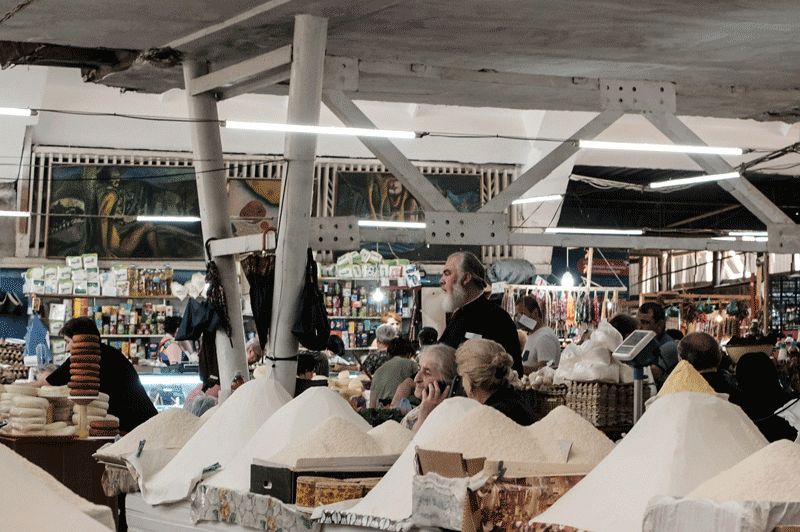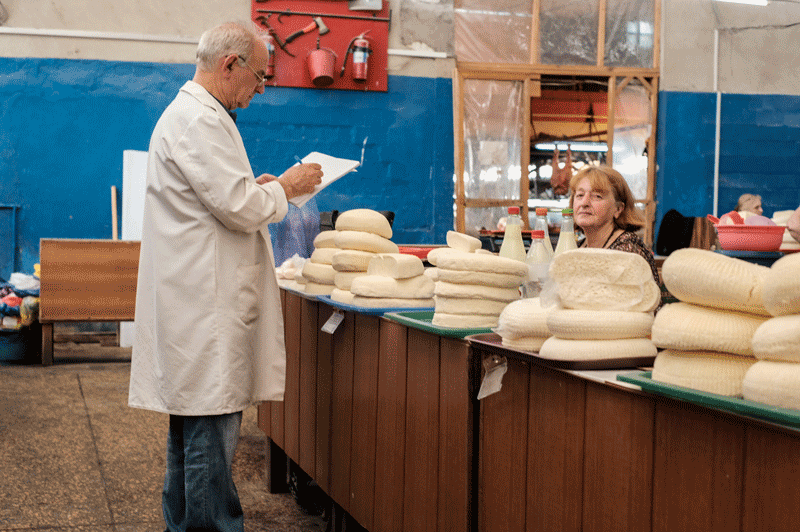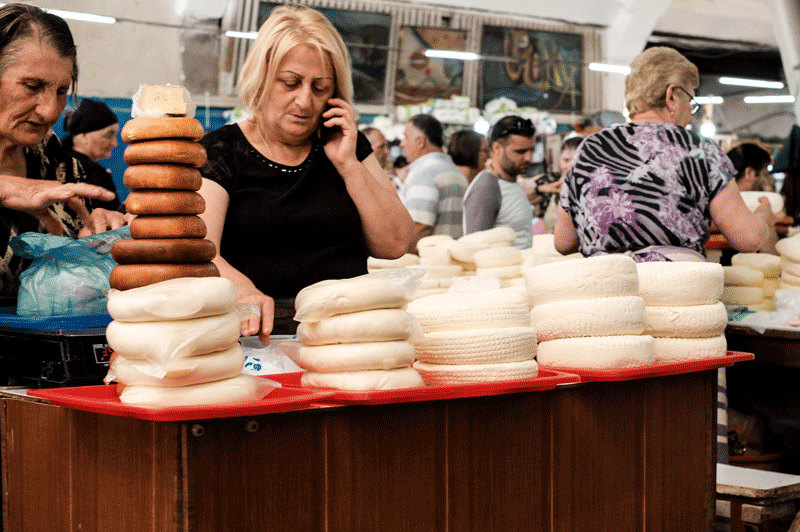The „Green Bazaar“ is located in the centre of Kutaisi. It is the main supply centre for the population living in the city and the surrounding area. At the same time, it is an excellent example of the high esteem in the Georgian culture for the value of food and drink. Despite the simplicity of many stalls, the traders and the thoughtful design of the stalls radiate a great deal of joie de vivre.
The article series "Georgian Perspectives" provides insights and analyses of contemporary Georgian social life from a geographical viewpoint. This means that all articles examine the social space and the practices taking place within it. This includes both the built space and the non-built space and all communications about places and spaces. It is important to underline that the insights given here must always include views from the outside, as the author is neither a native speaker nor permanently living in Georgia.

On the western front is a frieze from the Soviet era. It follows a central demand of Stalin in its structure and presentation. The nations of the Soviet Union were to develop the best features of their national identity to merge into Soviet world culture (cf. Maisuradze, G. & Thun-Hohenstein 2015).
The bazaar consists of different elements of buildings and has been undergoing constant alterations for many years, whereby the halls dating from the Soviet era have been preserved until now. It is one of the largest covered markets in all of Georgia. On the one hand, new hall areas are added, some of which are two-storey. On the other hand, within the old parts of the building, the smaller shops are being merged, following the example of western supermarkets. There, the division into branches is abandoned.





Vegetable and fruit stands fill the main hall of the Kutaisi bazaar.
However, the largest sections of the Kutaisi bazaar still follow the principle of division into branches or products such as dairy products, vegetables and fruit, clothing, household goods, etc. Competition between individual suppliers is thus largely ruled out since all of them offer the same products in the immediate neighbourhood. The prices for all goods are very low compared to European prices for food, and so are the profit margins for the traders. Nevertheless, it is the case that the slowly rising prices are a major concern for most Georgians because only a few have a permanent job and earn money regularly.








The bazaar is divided into different branches.
The centre of the bazaar is the market for vegetables and fruit, which was built in the Soviet era. The Soviet system knew so-called private farmland in addition to the collective land. On these areas, the farmers and other employees from other branches of the economy were allowed to provide themselves with self-sufficient agricultural work. Besides, they were allowed to sell surplus produce at the kolkhoz markets which were not tied to prices. The internal structural problems of Soviet agriculture cannot be discussed here (cf. Brooks 1988, Hedlund 1989). In brief, however, it can be stated that the productivity on private farmland exceeded the productivity of the collective farms and sovkhozes, especially for labour-intensive agricultural products. Over many phases of the Soviet Union, the supply of food to the population was only possible through private farm farming, which was contrary to socialist logic.



The stable, brick-built stalls still bear the numbers from the Soviet era.
After the collapse of the Soviet Union, the initially surprising effect in Russia and the post-Soviet states was that people fled not the countryside but the cities because of the threat of poverty. For there they had the opportunity to grow their vegetables and fruit and keep small livestock on old dacha plots or former family estates. In the end, the citizens of the Soviet Union, even if they were academics or industrial workers, could never afford to unlearn gardening. After all, gardening ultimately ensured their primary supply. Even today, the situation in Georgia is still so precarious for the majority of the population that many families are dependent on the production of food for self-sufficiency (cf. Lindner 2013).




Organizing daily life is not always easy in Georgia.
The circumstances of life in Georgia are highly dependent on chance and tend to be outside individual control. The economic and social crisis which rocked the country brought with it a decline in skills which the poor state of the country’s education systems exacerbated. Poverty perpetuates itself down generations. In accordance with these difficult circumstances, labour migration, trade in home-grown produce at small-scale markets, and family and clan networks continue to be mainstays of economic survival in Georgia (cf. Gugushvili 2011, 16-18). The ‘Caucasus Barometer’ for 2019 reported that 15 per cent of the population found themselves with insufficient funds to feed themselves and their families daily in the course of a month, while 34 per cent, although they had enough money for food, could not afford clothing. The proportion of those dependent on the proceeds from selling the produce of small-scale subsistence farming stood at 28 per cent, and only 40 per cent received a more or less regular wage. Of those deemed low earners, 26 per cent reported needing a minimum of about 250 US dollars per month to cover necessary household expenses for themselves and their families and live ‘normal lives’; less than half (52 per cent) of the population have household incomes of 50-250 US dollars, and the average monthly old age pension stood at 50 US dollars (cf. Caucasus Barometer 2019). Pensions are crucial to supporting households within extended families among 59 per cent of the population. For some years, reports have been emerging of increasing levels of household debt in Georgia, accrued in what are usually futile attempts by families to lift themselves out of the poverty trap (cf. Lomsadze 2018).



Especially older people with low pensions spend the whole day at often improvised stalls. These are located at small side passages of the bazaar complex or on the sidewalks in the neighbourhood of the bazaar.
In addition to the bazaar, there is a shopping centre in the centre of Kutaisi following the western model, with a cinema, several clothes shops and many small shops for other needs such as toys, haberdashery, household goods, cosmetics etc. However, there are still larger shop areas vacant – this new building does not represent serious competition for the green bazaar.
On the one hand, this is a good sign that the central market, which is also a public cultural good, will retain its importance. On the other hand, it also reflects the fact that the supply situation of a significant part of Georgia’s population remains precarious.
Text: © Stefan Applis (2020)
Photography: © Stefan Applis (2019)
References
Brooks, K. M. (1988): Food Problems. Science, vol. 240, no. 4851, 1988, pp. 547–548. JSTOR, www.jstor.org/stable/1701198 (Date 11 July 2020)
Caucasus Research Resource Centers. 2019. Caucasus Barometer. Tbilisi. http://www.crrccenters.org/caucasusbarometer (Date: 10 Juli 2020)
Gugushvili, A. (2011): Understanding poverty in Georgia. In: Caucasus Analytical Digest 34, 16–18. http:// www.laender-analysen.de/cad/pdf/CaucasusAnalyticalDigest34.pdf (Date: 10 Juli 2020)
Hedlund, S. (1989): Private Agriculture in the Soviet Union. London, New York: Routledge.
Lindner, P. (2013). Situating Property in Transformation: Beyond the Private and the Collective. Europe – Asia Studies, 2013, Vol.65(7), p.1275. http://dx.doi.org/10.1080/09668136.2013.822698
Lomsadze, G. (2018): Georgia’s predatory lenders are punishing the poor. Georgian indebtedness has reached crisis proportions. And lenders take scant look at customers’ creditworthiness. Eurasianet. https://eurasianet.org/s/georgias-predatory-lenders-are-punishing-the-poor (Date: 10 Juli 2020)
Maisuradze, G. & Thun-Hohenstein, F. (2015): Sonniges Georgien. Figuren des Nationalen im Sowjetimperium [engl. Sunny Georgia. Figures of the National in the Soviet Empire]. Berlin.

Hello Dear, are you truly visiting this site regularly, if so afterward you
will without doubt obtain pleasant know-how.
LikeLike
Hi, the idea is that as a tourist, after reading the articles on the blog, you can see more and understand the space better once you are in the places yourself. I work as a geographer in the region and have been in Kutaisi several times a year since 2015.
LikeLike